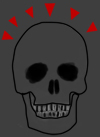I forgot where I was earlier this week.
I was somewhere between working on my article and teaching my new class. The third thing to come out of my mouth is about this magnificent perspective-altering software that I used to reorganize my class discussion/presentation notes. I was stupefied by the way in which handling the indexed notes to Nella Larsen's Passing--a book whose direct style has always felt to me soporific, facile--made the organization of those ideas memorable.
The process of organizing my sundry notes in presentation form always took upwards of half an hour and produced a more-or-less sequential list of main topics with subthreads following. To offset the arbitrary character of sequence that lineation, I'd find myself numbering in order of importance the points I wanted to cover. Of course, since the arbitrary sequencing of the topics was emphasized by the unidirectional flow of ideas down the page, my intuition regarding the relations between these topics would shift into survival mode and start tagging (with numerals that further reinforced arbitrary serialization) like concepts. This process usually culminated in a minor organization catastrophe and my teaching style for the day would, in many ways, be an attempt to impose mastery on this unwieldy and disparate cognitive framework that, ironically, I had produced just an hour or so earlier.
Sometimes, if I had a very long Sunday, I would finish reading early and start in on a set of notes the evening before. This would not only give me time to produce a framework to help me guide class discussion but also the time to study that framework so I could recall the next day the points I considered most important as well as have a sense of where the lesser ideas were and how they might connect together in order to be responsive to ideas the students wished to pursue. It was only the precipice of madness that kept me from taking notes on my notes.
Enter 2006.
I took an index I had produced the last time I taught this course (Fall 2005) and imported it into Tinderbox. Then I arranged the resulting notes using Tinderbox's map view. My usual pointing device started getting in my craw, so I resorted to my tablet and pen which further naturalized the process of clumping like topics together. I was using the map view to construct piles of like ideas. Five clusters formed representing "Clare," "Irene," "passing," "whites/blacks," and "homoeroticism." This took me about fifteen minutes, even though I was learning for the first time how to use Tinderbox in this way.
Of course, I considered every one of these points important to cover for our second class. The spatialized groupings helped me devise very quickly a strategy for presenting the ideas I thought important. The spatial nature of the groupings not only presented the ideas with a clarity that linear outlines obscured with the arbitrary and unavoidable hierarchy-due-to-sequence could not present, but the spatial groupings also served as a physical mnemonic device, aiding my ability to remember the several groupings themselves.
Class discussion had its normal starts and stops, but what surprised me was that a cross-section of students answered. Part of it, of course, had to have been the students' establishing a social hierarchy in this early part of the term. Even so, my sense was that the several waves of comments from students who had remained silent for a significant portion of the period might have been influenced by the topical variety I was able to offer for the students' consideration, a variety that was easy for me to pursue because the relationship between the ideas was clear to me as a result of the framework I had produced using Tinderbox as opposed to a wordprocessor.
The icing on the cake, though, was that when I returned home I decided to jot a few notes about the ideas which had been covered in class (partially anticipating my need to update the notes I had produced rather than start fresh Tuesday) was that much of the discussion came back to me. The software made it easy to recall the points I had covered in class, the ideas students had brought up, the things we discovered about the text together, and to add that information to my original framework. If I can maintain taking notes of the ideas generated by the class discussing, writing essay topics for the midterm paper and compose questions for the final exam will be much easier than it had been in the past when I would rack my brain and pore through my marginalia for the major themes we had covered in class.
Undoubtedly, there is a class of instructor who does not need knowledge representation software to assist their recall of the topics they cover in class, a well-organized instructor who knows the material being taught so well that even the subtlest interconnections are available for student conferences, paper grading, and exam writing. That person is not me.
A final class-related note. I realized that because I'd used Tinderbox to produce a highly-structured version of the course's daily syllabus that I could add, as a feature, a highlight color indicating the current preparation day. So, yesterday I added that highlight color, thinking to manually update it once every five and then two days, depending if it was Tuesday or Thursday. I'd resigned myself to forgetting to do so, to doing so incorrectly, to perhaps falling so far behind that I'd have given up providing the information as a matter of practice. So, I wrote a PERL script and assigned it to a cron job. Every Tuesday and Thursday at 1 pm, the old preparation material is returned to normal and the current preparation material is highlighted. This wouldn't have been thinkable if the data hadn't been placed within a predictable, descriptive and well-formed structure. In other words, this new approach to producing the information that provides structure for this class facilitates the development of features regarding that information. My students (and I) get a pretty color to tell them what portion of the daily syllabus is relevant.
Generally, what I'm noticing after this very short first week of classes is that I am not feeling rushed and deadlined out as I have for virtually every other term I've taught since 1997. I also feel, finally, that my main tool (the machines I refer to as "varmint," "pipsqueak," "baby," and "lefty") is facilitating my production of words rather than hindering them. I completed my dissertation despite my process being incomplete and on-the-verge of unruly. After finishing, I turned my attention again to the problem of how these machines can facilitate my textual process.
Some of that was greatly complicated by my being forced to become my own hosting service. That took nearly eight months to get straight. 
![]()
![]()

